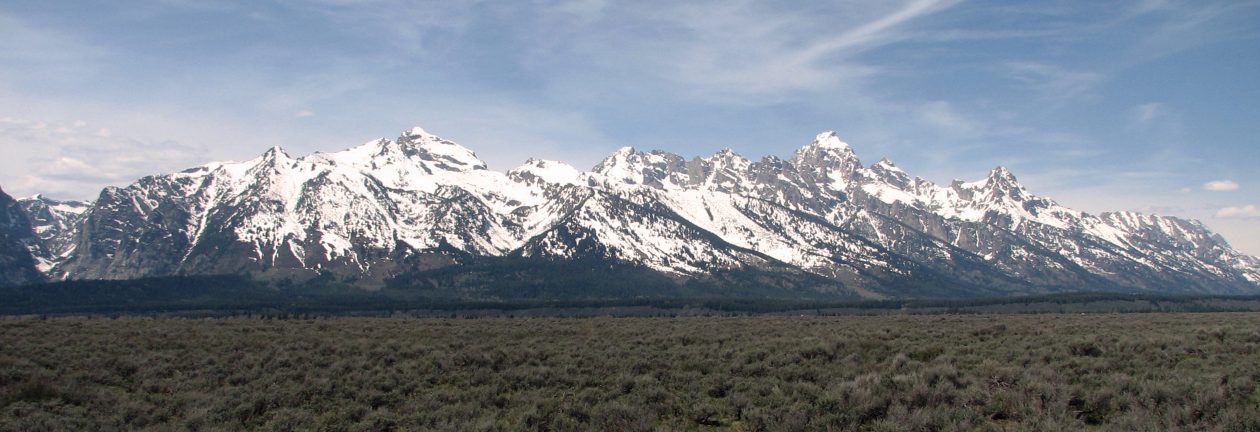Guilin, China
I slept in late today, but eventually rose out of bed at 09:30, showered, and dressed. I then packed my bags and stored them in a locker at the hostel; I also checked out and explained that my train is not scheduled to depart until 22:20 today, so I would be back to eat dinner and grab my bags. During my morning coffee inside the hostel, a slim, cute, Chinese woman (another guest in the hostel) took a picture with me, remarked on my looks, and was dismayed when I told her I was leaving today (unfortunately she had just arrived); between yesterday and today and even the past 38 days of my journey, I have come to the conclusion that any Western guy who visits China or any country in the Far East and feels the urge to buy a prostitute is fucking stupid; if an average-looking guy like myself is catching the eye of so many Asian women (I haven’t even shaved since I started this world tour), then certainly every “exotic-looking” man from the West has a good chance of making love to some fine Asian beauties if that’s what he wants to do.
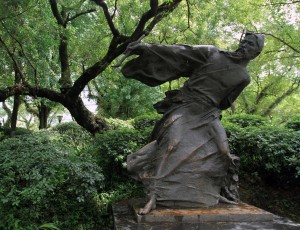
After that thought ran through my head, I walked down the steps from the hostel and right outside, near the riverbank, many tables were set up and filled with players either playing mahjong or cards (some were using western cards and others were using slim, longer cards with Chinese characters either in red or black type); the hostel is located directly above an establishment offering playing tables for use, so it figures during the day they would set up a number of tables outside; also, each day here in Guilin, I’ve noticed many people passing there time together with cards or mahjong pieces.
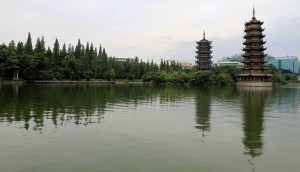
I then proceeded north to the Sun and Moon Pagodas since it was along the way and then continued in a northerly direction to the Ming Prince Mansion. The entrance fee was exorbitant for what there was to offer – 130 ¥. Inside Chengyun Palace (the primary building on the scenic area grounds, which was originally built in 1372 AD – the fifth year of the Hongwu Reign of the Ming Dynasty -, but was burned down twice during the Qing Dynasty and the Japanese invasion – eventually the palace was rebuilt in 1947 AD), there were a number of rooms with exhibits on the history of the palace, but it was all in Chinese and the displays were mostly all photos reprinted on boards. I soon left the palace, checked out the Resting Palace, which is now a theater, and hurried to Solitary Beauty Peak at the north end of the mansion grounds. The north end of the compound is where all the best structures are located for one to see.
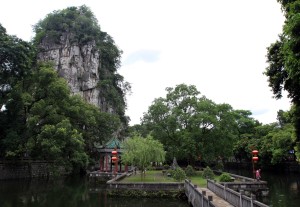
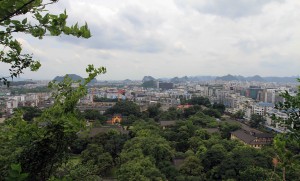
Next to Solitary Beauty Peak, there is a pond with pavilions, a walkway, and monuments. At the base of the mountain are two caves: Reading Cave which has a stairway leading down, but was blocked off due to being filled with water; Peace Cave which has three entrances, each with closed double doors; I opened one of the doors to Peace Cave and found several passageways which have been expanded by tunneling and along the walls of the tunnels were etched portraits of the sixty Guardian Gods. After walking around in the damp cave I exited through a gift shop and then climbed up the many steps to the top of Solitary Beauty Peak. From there I could see much of Guilin and the palace grounds. I then descended and walked in to Guangxi Examination Cultural Exhibition Hall – the examination hall was built there during the Qing Dynasty and was once the largest examination place for provincial exams in Southwest China and it produced 585 Jinshi (successful candidates in the national-level examinations). I walked through the exhibits which showcased artifacts associated with the exams (scrolls, ink fountains, lamps, etc.) and then joined up with a Chinese tour group. The tour group was watching a performer in costume read a decree for the Imperial Exams; then the group was led to the examination corridor which had many booths lined along one side, where the members of the group were seated and given a short exam to complete; after the examinations, they were led to the Confucius Temple, where the examinees with the best score were dressed up and awarded prizes. After that show, I walked around the grounds a little more before exiting and continuing north through Guilin.
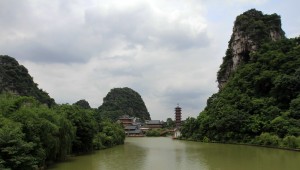
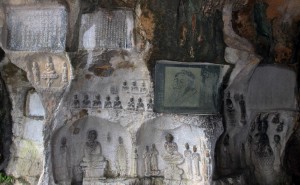
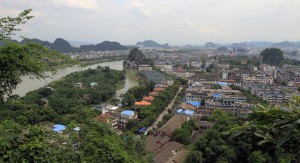
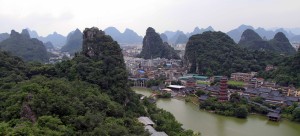
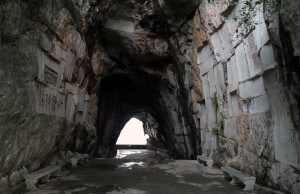
I walked through one of the parks toward the northwest part of Guilin; I had the park all to myself and other than the incessant noise created by many unseen crickets, it was rather peaceful. I then headed east to Diecai mountain, paid the entrance fee to the park (35 ¥ – much more reasonable), and proceeded to hike up the four peaks of Diecai. I completed the two smaller peaks first before moving on to the highest (Bright Moon Peak, named so because when standing on top of it, the moon is within reach). The top of Bright Moon Peak offered incredible 360-degree views of the city, the rivers, and surrounding mountain peaks. I then decided to descend the peak using the “Good Luck Slide”, which was easier on the knees than walking down, but not much fun. I then hiked up Crane Peak, which had a large cave cut through the mid-section of the peak, allowing a pleasant breeze to squeeze through (this cave was used by Chinese forces during the Japanese Invasion and doubled as a bomb shelter for local residents. After taking in the views from the top of Crane Peak, I descended down the steps (I went up and down a lot of steps today and the hot and humid weather ensured I was drenched in sweat), and headed south along the Li River.
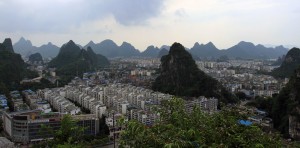
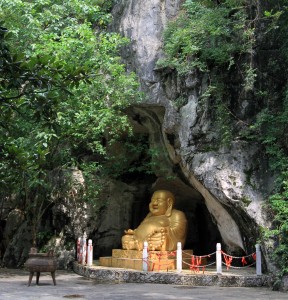
There were a number of bathers in the Li River soaping up and washing off, as well as many fishermen and across the river I could see a number of children wading and playing in the waters. I then passed by the Sun and Moon Pagodas one last time before making it back to the hostel, where I used the public shower to clean myself and cool off. I then sat down and typed for some time, as well as researched how to get from Guangzhou to Hong Kong. I then had a supreme pizza that was overflowing with ham, onions, garlic, and tomatoes for dinner. At about 21:10 I walked to the train station, checked in, and at 22:10 boarded the train. There was much noise, people talking, and passengers walking back and forth throughout the night; I was fortunate to get any sleep at all.
